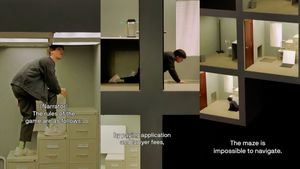
Video Source: Advocate Channel
(CNN) — Firefighters want every leg up they can get to knock out a blaze before it becomes an inferno. The California Department of Forestry and Fire Protection says it has a new tool to battle wildfires before they explode – artificial intelligence.
“I think it is a game changer … It has enhanced our abilities to validate situational awareness and then respond in a quick fashion,” Phillip SeLegue, Cal Fire’s staff chief for fire intelligence, told CNN.
Deep in the California wilderness of the Cleveland National Forest in San Diego County, a fire started in the middle of a July night. No fire officials were in the area, but AI was watching and alerted the authorities.
“The dispatch center there was not aware of the fire,” said Scott Slumpff, battalion chief of the intel program at Cal Fire, who was testing the new technology at the time and received the initial alert.
Cal Fire, in partnership with the University of California at San Diego’s Alert California program and its network of more than 1,000 cameras across the state, is using the technology to spot fires early.
“The camera had done its 360 [degree turn], identified an anomaly, stopped and was zoomed in,” Slumpff explained. He then confirmed it was a fire and immediately dispatched resources. “They were able to hold it to a 10 by 10 [foot] spot out in the middle of the forest.”
“The next morning, that fire would have been a fire of significance” without the AI detection, SeLegue said.
The cameras, usually placed in the mountains so they have a higher vantage point, are constantly scanning their surroundings in 2-minute rotations; AI looks for any changes which it highlights in a red rectangular box on the screen.
“Once the camera system detects an anomaly, which is a different version of the last image, it red flags it,” said Dean Veik, a fire department liaison for Alert California and a former firefighter. “It’s predominantly looking for smoke.”
The cameras themselves are not new – Cal Fire has used them for years to watch for fires. They are also publicly accessible: anyone can watch the network of view sheds to see weather conditions in real time or catch a glimpse of a curious creature like a bald eagle using the tower as a perch.
After detecting smoke, Cal Fire continues to monitor the video streams for “situational awareness” of a fire – where it’s heading and whether it is “encroaching on critical infrastructure,” said SeLegue. Law enforcement can even use it to identify suspected arsonists.
The pilot program was so successful, Cal Fire expanded the technology at the beginning of September to all 21 of its dispatch centers across the state.
“Our goal as an agency is to keep 95 percent of our fires at 10 acres or less, so this tool increases our ability to ensure that we’re keeping those fires small in the incipient phase,” said SeLegue, adding the cameras can see about 70 miles out during the day and approximately 110 miles out at night. “We have multiple successes of fires at night that had gone undetected that we were able to suppress before a 911 call had even come into the command centers.”
Cal Fire says 40 percent of fires since July 10 have been detected by AI before a 911 call was received – and the technology is continuing to learn and improve.
The system is looking for changes on the horizon, said Alert California’s Brian Norton, who spent 35 years in the fire service. Sometimes it’s going to be smoke from a wildfire. Other times it’s going to be something harmless, like mist or dust.
The trick is teaching the AI to know the difference.
“The learning part of it comes in with the human intervention to say ‘that looked like smoke, but that wasn’t smoke; it was dust,’” Norton told CNN. “Then the next time the camera picks something up, it’s less likely to say that that is smoke.”
Traditionally, people in the dispatch centers would have to endlessly watch those video feeds looking for “a needle in a haystack,” Slumpff said. “Eye fatigue” was always a concern as officials were constantly scanning possibly hundreds of feeds at a time.
Now, with the help of AI, they spend time focusing on the anomalies the technology has detected.
There are also lookout towers throughout the state, some staffed by fire personnel, others with volunteers. At Boucher Hill lookout tower in San Diego County, volunteer Bill Angel of the Forest Fire Lookout Association is in his second season of keeping an eye out for wildfires. His tower is just a few yards away from where the cameras are positioned on a communications tower.
The AI technology has “enhanced looking for fires but it still requires humans,” he said while keeping watch over the vast valley below, often raising his binoculars to his eyes. “If lightning strikes the tower, they’re blind but we are here.”
The firefighters agree, convinced this new technology is making a difference – and won’t threaten human jobs.
“Nothing can take the place of the boots on the ground,” said Slumpff. “We absolutely are able to, in my opinion, save lives and property.”
“The fires you don’t hear about in the news is the greatest success,” SeLegue said.
The-CNN-Wire
™ & © 2023 Cable News Network, Inc., a Warner Bros. Discovery Company. All rights reserved.


















































